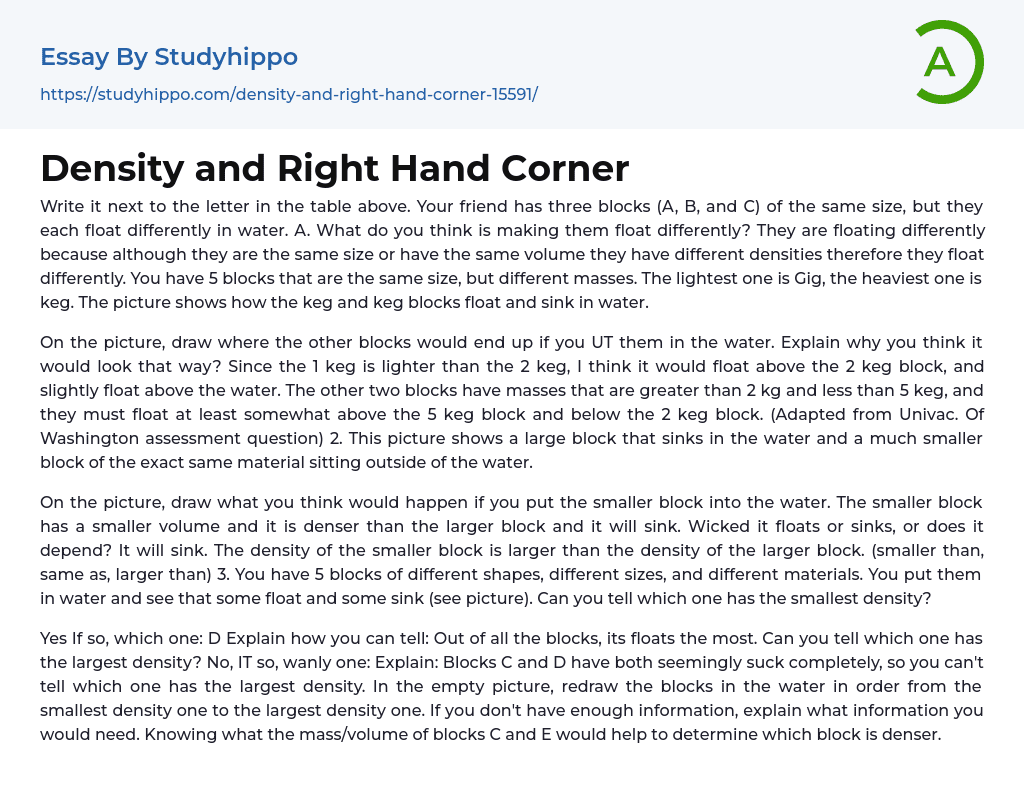Write it next to the letter in the table above. Your friend has three blocks (A, B, and C) of the same size, but they each float differently in water. A. What do you think is making them float differently? They are floating differently because although they are the same size or have the same volume they have different densities therefore they float differently. You have 5 blocks that are the same size, but different masses. The lightest one is Gig, the heaviest one is keg. The picture shows how the keg and keg blocks float and sink in water.
On the picture, draw where the other blocks would end up if you UT them in the water. Explain why you think it would look that way? Since the 1 keg is lighter t
...han the 2 keg, I think it would float above the 2 keg block, and slightly float above the water. The other two blocks have masses that are greater than 2 kg and less than 5 keg, and they must float at least somewhat above the 5 keg block and below the 2 keg block. (Adapted from Univac. Of Washington assessment question) 2. This picture shows a large block that sinks in the water and a much smaller block of the exact same material sitting outside of the water.
On the picture, draw what you think would happen if you put the smaller block into the water. The smaller block has a smaller volume and it is denser than the larger block and it will sink. Wicked it floats or sinks, or does it depend? It will sink. The density o
the smaller block is larger than the density of the larger block. (smaller than, same as, larger than) 3. You have 5 blocks of different shapes, different sizes, and different materials. You put them in water and see that some float and some sink (see picture). Can you tell which one has the smallest density?
Yes If so, which one: D Explain how you can tell: Out of all the blocks, its floats the most. Can you tell which one has the largest density? No, IT so, wanly one: Explain: Blocks C and D have both seemingly suck completely, so you can't tell which one has the largest density. In the empty picture, redraw the blocks in the water in order from the smallest density one to the largest density one. If you don't have enough information, explain what information you would need. Knowing what the mass/volume of blocks C and E would help to determine which block is denser.
- Animals essays
- Charles Darwin essays
- Agriculture essays
- Archaeology essays
- Moon essays
- Space Exploration essays
- Sun essays
- Universe essays
- Birds essays
- Horse essays
- Bear essays
- Butterfly essays
- Cat essays
- Dolphin essays
- Monkey essays
- Tiger essays
- Whale essays
- Lion essays
- Elephant essays
- Mythology essays
- Time Travel essays
- Discovery essays
- Thomas Edison essays
- Linguistics essays
- Journal essays
- Chemistry essays
- Biology essays
- Physics essays
- Seismology essays
- Reaction Rate essays
- Roman Numerals essays
- Scientific Method essays
- Mineralogy essays
- Plate Tectonics essays
- Logic essays
- Genetics essays
- Albert einstein essays
- Stars essays
- Venus essays
- Mars essays
- Evolution essays
- Human Evolution essays
- Noam Chomsky essays
- Methodology essays
- Eli Whitney essays
- Fish essays
- Dinosaur essays
- Isaac Newton essays
- Progress essays
- Scientist essays




